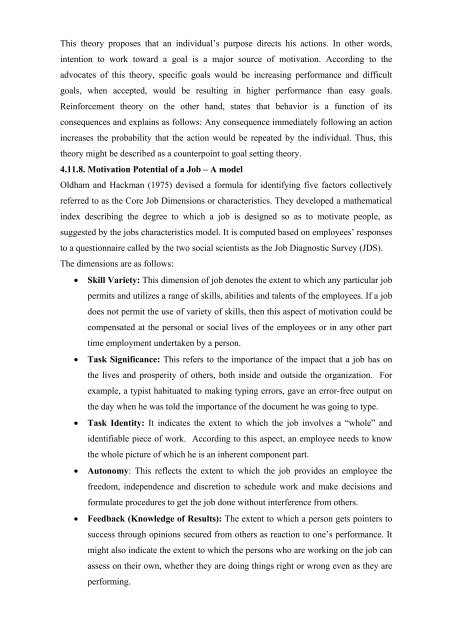UNIT – I Lesson 1 HRM – AN OVERVIEW Lesson Outline Nature of ...
UNIT – I Lesson 1 HRM – AN OVERVIEW Lesson Outline Nature of ...
UNIT – I Lesson 1 HRM – AN OVERVIEW Lesson Outline Nature of ...
You also want an ePaper? Increase the reach of your titles
YUMPU automatically turns print PDFs into web optimized ePapers that Google loves.
This theory proposes that an individual’s purpose directs his actions. In other words,<br />
intention to work toward a goal is a major source <strong>of</strong> motivation. According to the<br />
advocates <strong>of</strong> this theory, specific goals would be increasing performance and difficult<br />
goals, when accepted, would be resulting in higher performance than easy goals.<br />
Reinforcement theory on the other hand, states that behavior is a function <strong>of</strong> its<br />
consequences and explains as follows: Any consequence immediately following an action<br />
increases the probability that the action would be repeated by the individual. Thus, this<br />
theory might be described as a counterpoint to goal setting theory.<br />
4.11.8. Motivation Potential <strong>of</strong> a Job <strong>–</strong> A model<br />
Oldham and Hackman (1975) devised a formula for identifying five factors collectively<br />
referred to as the Core Job Dimensions or characteristics. They developed a mathematical<br />
index describing the degree to which a job is designed so as to motivate people, as<br />
suggested by the jobs characteristics model. It is computed based on employees’ responses<br />
to a questionnaire called by the two social scientists as the Job Diagnostic Survey (JDS).<br />
The dimensions are as follows:<br />
• Skill Variety: This dimension <strong>of</strong> job denotes the extent to which any particular job<br />
permits and utilizes a range <strong>of</strong> skills, abilities and talents <strong>of</strong> the employees. If a job<br />
does not permit the use <strong>of</strong> variety <strong>of</strong> skills, then this aspect <strong>of</strong> motivation could be<br />
compensated at the personal or social lives <strong>of</strong> the employees or in any other part<br />
time employment undertaken by a person.<br />
• Task Significance: This refers to the importance <strong>of</strong> the impact that a job has on<br />
the lives and prosperity <strong>of</strong> others, both inside and outside the organization. For<br />
example, a typist habituated to making typing errors, gave an error-free output on<br />
the day when he was told the importance <strong>of</strong> the document he was going to type.<br />
• Task Identity: It indicates the extent to which the job involves a “whole” and<br />
identifiable piece <strong>of</strong> work. According to this aspect, an employee needs to know<br />
the whole picture <strong>of</strong> which he is an inherent component part.<br />
• Autonomy: This reflects the extent to which the job provides an employee the<br />
freedom, independence and discretion to schedule work and make decisions and<br />
formulate procedures to get the job done without interference from others.<br />
• Feedback (Knowledge <strong>of</strong> Results): The extent to which a person gets pointers to<br />
success through opinions secured from others as reaction to one’s performance. It<br />
might also indicate the extent to which the persons who are working on the job can<br />
assess on their own, whether they are doing things right or wrong even as they are<br />
performing.
















